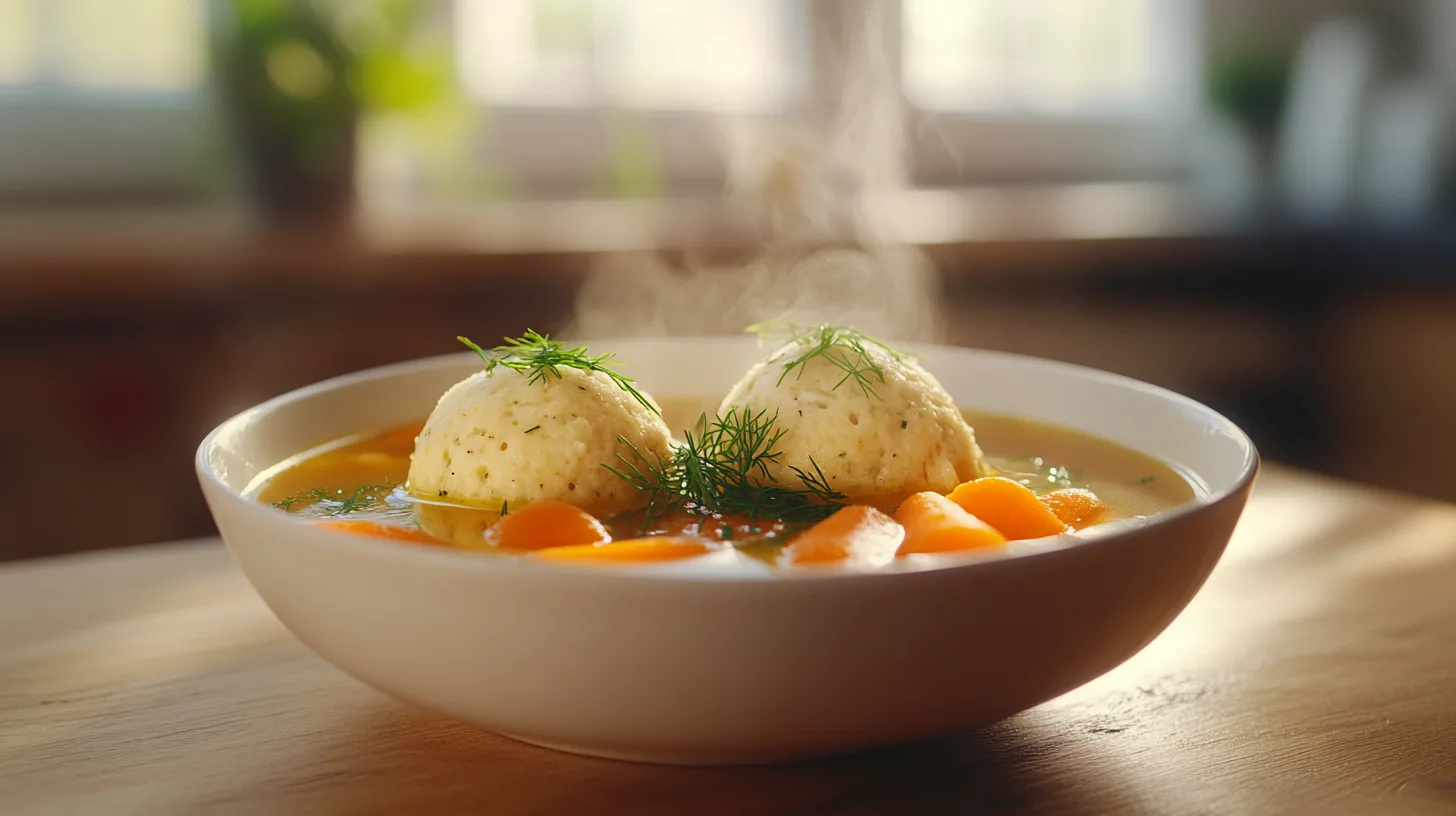One Little Mistake Everyone Makes When Learning How to Make Matzo Balls
Making matzo balls should be simple, right? Just mix some stuff together, drop it in broth, and bam – instant Jewish grandma cred. But here’s the thing most folks don’t talk about: your matzo balls don’t have to be dense little sinkers.
We’ve been there, gooey middles, rubbery outsides, or worse, falling apart in the pot.
We’re gonna fix that.
You’re gonna learn how to make matzo balls that are light, fluffy, and full of flavor.
The trick isn’t fancy gear or hard-to-pronounce spices.
It’s knowing the why behind the ingredients, and how a couple small choices change everything.
Let’s roll.
Disclosure
I’m not a traditionally trained Orthodox Jewish chef. This recipe comes from a deep respect for the heritage and a love for sharing food that brings people together. It’s my way of honoring the tradition while offering what I know best – flavor, technique, and heart. If you’re making this during Passover or for a religious celebration, please follow the guidelines that are meaningful to you and your family.
Ingredients
Each part of a matzo ball recipe plays a role. Miss one, and the whole thing can wobble.
- Matzo meal (1 cup): Ground-up matzo crackers. It’s the main base and gives the signature texture.
- Eggs (4 large): These hold everything together. More eggs = firmer balls.
- Schmaltz (2 tbsp): Rendered chicken fat. Rich, classic flavor. You can swap for vegetable oil if you must.
- Seltzer water (1/4 cup): Yep, the bubbly kind. It keeps them light instead of hockey-puck heavy.
- Kosher salt (1 tsp): Don’t use table salt. It tastes way too sharp in this recipe.
- Garlic powder (1/4 tsp) + Onion powder (1/4 tsp): Adds mellow background depth.
- Fresh dill or parsley (1 tbsp, chopped): Totally optional. Fresh herbs brighten everything.
- Chicken broth (5 quarts): Where the magic happens. We also toss in 4 smashed garlic cloves for a rich base.
Want to see how it all comes together in a full bowl of comfort? Check out our complete Matzo Ball Soup Recipe for the final step that brings everything to life.
Step-by-Step Instructions

Let’s break it down so you don’t have to guess.
- Mix the wet stuff first. In a medium bowl, beat the eggs with the schmaltz or oil until smooth.
- Add dry ingredients. Stir in matzo meal, salt, garlic powder, onion powder. Combine it gently.
- Add the bubbles. Pour in the seltzer and give it a light mix. Toss in the herbs if you’re using ‘em.
- Chill it. Cover the bowl and let it sit in the fridge for at least 30 minutes. This lets it firm up.
- Make your balls. Wet your hands and gently form 1-inch balls. Don’t pack ‘em tight.
- Boil the broth. Get your chicken broth bubbling, drop in the smashed garlic cloves.
- Simmer time. Drop the matzo balls in, reduce to a simmer, and cover. No peeking. Cook 30–40 minutes.
- Serve hot. Ladle broth into bowls, add a couple matzo balls, and enjoy.
Tips for Light and Fluffy Matzo Balls
Some folks like ‘em dense, but most of us want that perfect float. Here’s how:
- Don’t overmix. Stir just enough to combine. More stirring = tougher texture.
- Chill that dough. Don’t skip this. It makes the mix hold together when shaping.
- Keep ‘em loose. Roll the balls gently. If they’re too tight, they’ll be chewy.
- Seltzer is your friend. Adds airiness without messing with flavor.
Ingredient Substitutions
Can’t find something? No big deal.
- No schmaltz? Use avocado oil, olive oil, or melted butter (if not keeping kosher).
- No seltzer? Use cold water, though the balls won’t be quite as fluffy.
- Gluten-free? Use gluten-free matzo meal. Texture might shift a little, but it works.
Nutrition Facts (Per Serving)
- Calories: 150
- Protein: 5g
- Fat: 8g
- Carbohydrates: 15g
- Fiber: 1g
- Sodium: 350mg
(Estimate is for 2 matzo balls in broth.)
Serving Suggestions

Classic way: 2 matzo balls floating in hot chicken soup with carrots, celery, and fresh dill.
Got leftovers? They’re great cold, straight from the fridge. Weird but good.
Storage & Reheating
- Fridge: Store matzo balls separate from broth. Keeps them from getting soggy.
- Freezer: Freeze on a sheet pan, then transfer to a bag. Reheat straight in broth.
- Microwave? Sure, but simmering them back in broth is better.
FAQs On How To Make Matzo Balls
Matzo ball mix usually contains matzo meal, salt, onion powder, and sometimes baking powder or other spices. It’s basically pre-seasoned ground matzo crackers.
A few things help here: seltzer water, not overmixing the dough, and chilling the mixture before shaping. Also, simmering them gently with the lid on locks in the steam that helps them puff.
You can crush saltines to mimic matzo meal, but the flavor and texture won’t be the same. Matzo is just flour and water, while saltines have fat and leavening – so results will vary.
Matzo is made under strict supervision to meet kosher guidelines, especially for Passover. That plus short production windows and limited demand raise the cost.
Most mixes call for 2 eggs per cup of mix. Always check the box, but 2 eggs is a good rule of thumb for a fluffy result.
Yes, if they simmer too long they can get waterlogged or start to break apart. Stick to 30–40 minutes in gently simmering broth.
They should be floating and puffed up. Cut one open – it should be cooked through with no raw center. A light, spongy texture is what you want.
Both are dough cooked in liquid, but matzo balls are made from matzo meal (unleavened bread), while dumplings usually use flour and baking powder or soda. Different texture, different roots, same cozy vibe.
Yes. Shape and chill the mix up to a day before. You can also cook them and store them separately from the broth.
Probably didn’t chill the mix long enough or added too much liquid.
Only if you use gluten-free matzo meal. Regular matzo meal has wheat.
Nope. Oil works. Schmaltz just gives that nostalgic flavor.
Sure, just salt the water well and toss in garlic or herbs to add flavor.
Nope. Gotta simmer ‘em. That’s how they get that pillowy center.
About 12–14 medium balls, enough for 6 people.
The Final Bite
That’s all it takes to make matzo balls that hit the mark every time. If you’re hungry for more timeless recipes like this, we’d love to have you join our Simply Delicious Newsletter. It’s where we share kitchen wisdom, no fluff, straight from chefs who cook for a living.
This piece was written by Ryan Yates, a working executive chef with 20 years of experience in commercial kitchens. What you read here? Comes straight from the line.
About the Author
Ryan Yates is a culinary expert with over 20 years of experience in commercial kitchens. As a working executive chef, he has a passion for creating delicious, accessible recipes that bring joy to home cooks everywhere. Ryan believes in the magic of simple ingredients and loves sharing his knowledge to help others find happiness in cooking.


